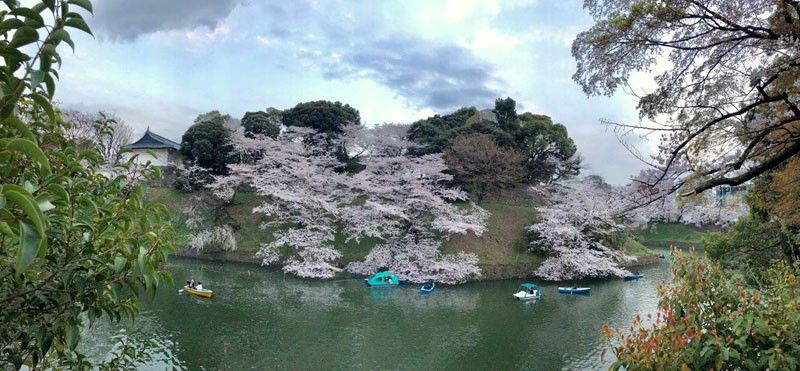Transience in Tokyo

My wife Beng and I have been to Japan — on our own and together — a few times, but not until last week did we go there just to immerse ourselves for seven days in one place, not trying too hard to see or do or buy too many things. The place was Tokyo, which Beng and I last visited as a couple almost 20 years ago, a depressingly downscale sortie from which Beng can only remember living off the nearby 7-11 and slurping rice gruel with construction workers beneath a bridge. With my retirement then looming, I booked this trip last year, well in advance of the 2019 cherry-blossom season, which Beng had expressed a longing to catch. I thought it was a chance to make up for that sorry first outing and for making new memories.
Wherever we travel, Beng and I always have two sure targets in mind: museums and flea markets. The museums provide an intimate feel of the history of the place, and the flea markets — well, they a have a bit of the museum in them, bits you can actually buy and bring home. (Indeed, we often remember cities — London, Paris, Amsterdam, Barcelona, Beijing, Seoul — less for their landmarks than for their flea markets.) For this Tokyo trip, we also resolved to enjoy the cherry blossoms and to look into as many fountain-pen shops as we could.
The Japanese fascination with cherry blossoms — that perennial signal and reminder of the transience of beauty and of life itself — is well known. As our friend Julie Hill puts it in her book Privileged Witness, “Cherry blossoms are a punctual miracle, a well-rehearsed event in the annual Japanese calendar. They first appear in the southern part of the archipelago, around the subtropical islands of Okinawa. As the weather gets warmer, cherry trees flower in central Japan; and in two weeks, depending on the weather, they will make their presence in Tokyo, achieving their full glory in the parks — Ueno park is a famous spot — and the gardens bordering the Imperial Palace.
“For weeks preparations have been underway in Kyoto; paper blossoms have been fluttering off lampposts and major downtown stores; newspapers and television channels have run elaborate charts of the sakura zensen — the cherry blossom — as part of the daily weather forecast. There are many varieties of trees, some occurring in the wilds of Japan, featured in gardens and parks as a cultivated tree. Others are bred as flowering trees with over-large, over-pink and over-endowed petals. The most popular are those with small pink flowers held in compact clusters.”
The sakura bloomed early this year — the weather in Tokyo was nippy to almost chilly—but we caught showers of them in pink and white around the Imperial Palace, along the Meguro River, and in Ueno Park. Most fortunately, we stumbled into a bank of them in Chidorigafuchi Park just as it darkened, and suddenly the trees were lit up, lending ethereal magic to the scene. The only downer with these hanami or flower-viewing walks is that you’re doing them with several hundred other people looking for exactly the same thing —that perfect pose or shot under the same trees.
A quieter time can be had exploring the sakura in context, such as you might do at the Tokyo National Museum on the far edge of Ueno Park, fittingly at the end of a long walk under the flowering cherry trees. There the blossoms figure in everything from Hiroshige’s Edo Road prints to exquisite kimono and lacquered boxes and bowls — indeed, a recurring theme that can only resonate more poignantly in these times of fleeting joys and affections.
Speaking of fleeting joys, we had our fill of them at the Tokyo City Flea Market beside the Ohi Racecourse in Shinagawa, where we spent most of our Sunday morning. Beng and I are Japan surplus-shop regulars, and this was the mother of all of them, hawking everything from used clothes and vintage electronics to ceramics and scientific instruments. We walked away with a handsome thermometer/hygrometer, which Beng needs for her art restoration studio, for 100 yen (50 pesos) and a big leather bag to carry our stuff for 300 yen. My big find — adrift in a sea of bags and blouses — was a newish Pilot Custom 74 fountain pen, which normally retails for between $100 and $150, for less than P2,000.
That was before I ran into the mother lode of vintage pens at one stall, where the owner had kept them in translucent plastic boxes, not thinking that anyone would be interested in them, and not thinking that a persistent Pinoy with X-ray vision would spot Montblanc stars in a galaxy of caps. It was a real treasure trove that I would have gladly sold a car for were I a younger and hungrier collector, but after much dickering, I picked out just two prize pens, about which you’ll hear more in another report on pen hunting in Tokyo.
This time around, we had chosen a better hotel, well located near the Imperial Palace, small and rather expensive but impeccably clean as Japanese hotels go. We still found ourselves subsisting on the prepackaged rice-and-fish dinners at 7-Eleven (actually, they’re good and cheap!), so Beng and I celebrated the day (and yes, the transience of money) with a grand dinner at a steakhouse in our neighborhood in Chiyoda. A good time was had by all.
* * *
Email me at jose@dalisay.ph and visit my blog at www.penmanila.ph.



















